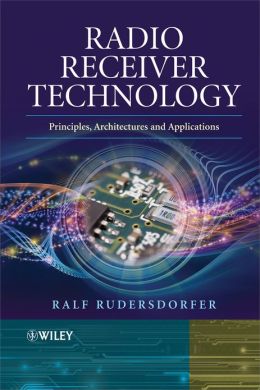 [内容简介]
[内容简介]
Written by an expert in the field, this book covers the principles, architectures, applications, specifications and characterizations of radio receivers
In this book, the author introduces the reader to the basic principles and theories of present-day communications receiver technology. The first section of the book presents realization concepts at the system level, taking into consideration the various types of users. Details of the circuitry are described providing the reader with an understanding of fully digitized radio receivers, offering an insight into the state-of-the-art.
The remaining sections address radio receivers, particularly as two-port devices. Furthermore, the author outlines the fields of applications (with sample calculations and with reference to practical work) and their features and considers also the specialty of high-quality radio receivers. As can be seen from the multitude of terrestrial applications described in Part II, they are typically used for radio surveillance, signal intelligence, modern radio bearing and at the classical radio services. Parts III and IV describe the entire range of parameters that are useful for the characterization of these receivers. The description starts from the physical effect, or the explanation of the individual parameter, and then proceeds to the measuring technique for determining the parameters, highlighting problems, followed by explanatory notes with applicatory relevance. The measuring procedures described are the result of experiences gained in extended laboratory work and practical testing. With the model shown in Part IV, used for the operational evaluation detailing the intrinsic small range of interpretation, the book covers untreated research in the field. The Appendix provides among others valuable information about the dimensioning of receiving systems and the mathematical derivation of non-linear effects and as well as a useful method for converting different level specifications.
Key Features:
- Introduces the basic principles and theories of present-day technology
- Discusses concepts at system level (aligned to the various types of users)
- Addresses (fully) digitized radio receivers focusing on the state-of-the-art
- Close contacts to the industry were utilized to show background information
- Enables the reader to comprehend and evaluate the characteristic features and the performance of such systems
- Examines the entire range of parameters that are characteristic of the technology including the physical effect and measuring techniques
- Includes results of experiences gained in extended laboratory work and practical testing with examples
- Provides a uniform and systematic approach for ease of understanding e.g. many didactic figures for the visual illustration have been newly created as well as complete real-world examples
This book will be an excellent resource to understand the principles of work, for professionals developing and testing radio receivers, for receiver users (e.g. at regulatory agencies, surveillance centers, secret services, classical radio communications services), technicians, engineers and technicians who work with RF-measurement instruments, postgraduate students studying in the field and university lecturers. Chartered radio amateurs and handlers/operators will also find this book insightful. Due to high level of detail, it also serves as a reference. By using the carefully edited alphabetical index with over 1,200 entries, the appropriate explanations can be found quickly in the text.
[目录]
About the Author xi
Preface xiii
Acknowledgements xv
I Functional Principle of Radio Receivers 1
I.1 Some History to Start 1
I.2 Present-Day Concepts 4
I.3 Practical Example of an (All-)Digital Radio Receiver 23
I.4 Practical Example of a Portable Wideband Radio Receiver 39
References 46
Further Reading 48
II Fields of Use and Applications of Radio Receivers 49
II.1 Prologue 49
II.2 Wireless Telecontrol 50
II.3 Non-Public Radio Services 54
II.4 Radio Intelligence, Radio Surveillance 64
II.5 Direction Finding and Radio Localization 83
II.6 Terrestrial Radio Broadcast Reception 101
II.7 Time Signal Reception 104
II.8 Modern Radio Frequency Usage and Frequency Economy 107
References 109
Further Reading 112
III Receiver Characteristics and their Measurement 113
III.1 Objectives and Benefits 113
III.2 Preparations for Metrological Investigations 114
III.3 Receiver Input Matching and Input Impedance 118
III.4 Sensitivity 121
III.5 Spurious Reception 147
III.6 Near Selectivity 156
III.7 Reciprocal Mixing 162
III.8 Blocking 171
III.9 Intermodulation 174
III.10 Cross-Modulation 199
III.11 Quality Factor of Selective RF Preselectors under Operating Conditions 204
III.12 Large-Signal Behaviour in General 209
III.13 Audio Reproduction Properties 213
III.14 Behaviour of the Automatic Gain Control (AGC) 218
III.15 Long-Term Frequency Stability 223
III.16 Characteristics of the Noise Squelch 226
III.17 Receiver Stray Radiation 227
III.18 (Relative) Receive Signal Strength and S Units 230
III.19 AM Suppression in the F3E Receiving Path 236
III.20 Scanning Speed in Search Mode 238
References 240
Further Reading 242
IV Practical Evaluation of Radio Receivers (A Model) 245
IV.1 Factual Situation 245
IV.2 Objective Evaluation of Characteristics in Practical Operation 245
IV.3 Information Gained in Practical Operation 249
IV.4 Interpretation (and Contents of the ‘Table of operational PRACTICE’) 253
IV.5 Specific Equipment Details 255
References 255
Further Reading 255
V Concluding Information 257
V.1 Cascade of Noisy Two-Ports (Overall Noise Performance) 257
V.2 Cascade of Intermodulating Two-Ports (Overall Intermodulation Performance) 260
V.3 Mathematical Description of the Intermodulation Formation 264
V.4 Mixing and Derivation of Spurious Reception 269
V.5 Characteristics of Emission Classes According to the ITU RR 272
V.6 Geographic Division of the Earth by Region According to ITU RR 272
V.7 Conversion of dB. . . Levels 272
References 278
Further Reading 279
List of Tables 281
Index 283

 新书报道
新书报道